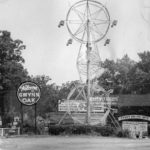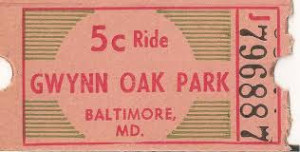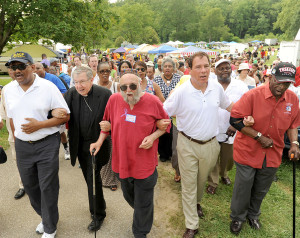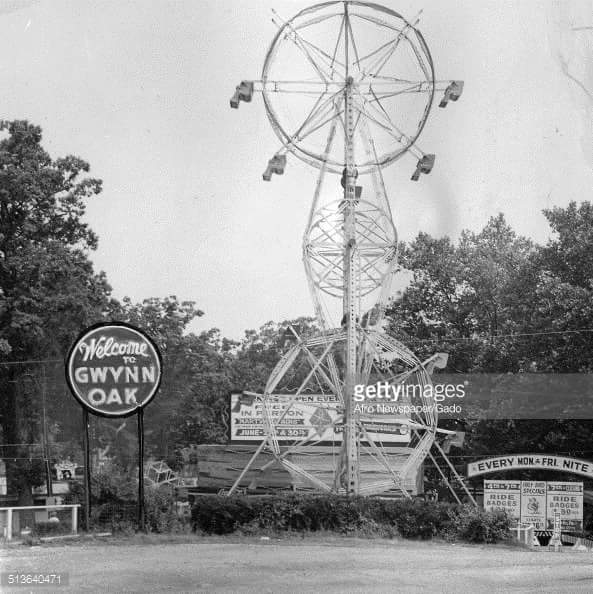 Reginald Leroy Johnson,
Reginald Leroy Johnson,
Randallstown, MD.
On my birthday in June 1963 my mother decided to take me to Gwynn Oak Amusement Park as birthday gift…
We rode on the #28 bus…leaving the city the air was so sweet and clean, I saw ducks, and trees.
I was so overwhelmed by this beauty…that I thought we where in “heaven”
the park was was nice. A miniature train ride, carrousel, and Ferris Wheel..this is where “race card” plays in.
I insisted that my mom put me on the Ferris wheel…I get on board and I’m the only one riding alone on the wheel.
all the other kids (white) was in the the other seats two and three across.
When my seat on the wheel arrived to the top it stopped for about 5min (it felt like 5 hours)…I panicked and called for my mother and as I looked down she was aggravated at the operator…she was so animated in her actions that I knew she was after the operator to let me down.
 He did eventually let me down(at his own pace and and speed), no hurry whatsoever.
He did eventually let me down(at his own pace and and speed), no hurry whatsoever.
As I got off the ride I heard him say to my mom …”this ‘ant ya’ll’s day”.
We left the park in silence…all these white people looking at us…I was scared all over again but, I did know why. My mom held me so close to her if she could fit inside her skin she would have that day.
We stood in silence as we waited for the bus to take us back into the city.
We got on the #28 and rode into town…we were the only ones on the bus for a while before we got to the city line.
All this time, my mom held my hand. Then her grip loosened, I looked up to her and saw her crying…not making a sound..it was a waterfall of tears so deep…drenching her blouse to her underwear. Her mouth open …no sound not a peep. By the time we got into town…she stopped crying.
She told me, as we got on the packed and hot #15 bus, that she was sick and that we could go another time she promised.
We never went back…ever.
READ MORE
REPOST: 50 years later, desegregation of Gwynn Oak Amusement Park celebrated
Former protesters, and child who broke color barrier by riding merry-go-round, return
July 07, 2013|By Lorraine Mirabella, The Baltimore Sun

Civil rights activists from the ’60s and others sing freedom… (Algerina Perna, Baltimore…)
The wooden roller coaster and the Dixie Ballroom are long gone.
Gone, too, from Gwynn Oak Park is the merry-go-round where a toddler in a pink dress took a historic spin on a summer afternoon a half-century ago.
That simple pleasure, a first for a black child at the formerly segregated Gwynn Oak Amusement Park, had become possible just weeks earlier in 1963 when hundreds of black and white protesters thrust Baltimore into the national spotlight and succeeded in integrating the park.
On Sunday, several hundred people filled the grassy Baltimore County park where the rides once stood, toting chairs and picnic lunches and sipping water in the sweltering heat, to mark the 50th anniversary of July 4 and 7 protests in 1963. Until then, nothing at the 64-acre park with picnic tables, playgrounds and a volleyball court hinted at that defining moment in Baltimore civil rights history, when nearly 400 people were arrested for trespassing, including nearly two dozen Catholic, Protestant and Jewish clergy members.
“I feel like we are righting a wrong by being here,” Baltimore County Executive Kevin Kamenetz said shortly before locking arms with clergy members and former protesters and leading a march to unveil a commemorative plaque.
“Opening the Gates,” sponsored by businesses, foundations and Christian, Jewish and Muslim groups, drew many of the original protesters who were jeered at by hecklers and jailed when they tried to enter the old amusement park.
Sharon Langley, now a Los Angeles resident who broke the Gwynn Oak racial barrier as a child, came back, too. And on display was the original wooden horse where Social Security Administration supply clerk Charles C. Langley Jr. had perched his 11-month-old daughter on Aug. 28, 1963, the same day Martin Luther King Jr. delivered his “I have a dream” speech. The horse’s private owners brought it to Gwynn Oak from its spot on the carousel, a ride on Washington’s National Mall since 1981.
Sitting at a shaded picnic table, Sharon Langley recalled coming back to the amusement park after that first time, playing skee-ball and learning to ice skate on the pond in winter. Sunday was her first time back since her family moved out of state after elementary school.
“So many ordinary people were part of civil rights,” said Langley, an elementary school administrator. “I’m glad my family felt this was an important thing to do. Every person has a part to play. Every person can do something in her community to move her community forward.”
Langley said she grew up knowing the Gwynn Oak visit was an important family event, but “I didn’t necessarily know it was still important to people.”
She found out otherwise, spending much of the day posing for pictures with people eager to meet her.
“That must have been some ride,” one woman said, shaking her hand.
As church and synagogue choirs sang, former protesters reminisced about the events of 50 years ago. Todd Gitlin had been a recent college graduate and activist with Students for a Democratic Society when he came to the July 4 protest, was arrested and spent the night in a packed jail cell. He returned for the July 7 protests and with others crossed a stream in the rear of the park to get in. Singing, the nonviolent demonstrators were met by angry mobs, recalled Alison Turaj Brown, another protester. A woman with a child threw a rock, which hit Brown in the head.
“All I know is I couldn’t see because of the blood,” said Brown, who lives in Sarasota, Fla.
The amusement park was different from the restaurants and theaters that the Congress of Racial Equality was pushing to integrate in the early 1960s, said Leo W. Burroughs Jr., 71, then a Morgan State College student and activist leader with CORE’s Baltimore chapter.
“That was the only large amusement park in the area,” said Burroughs, of Bolton Hill. “It was one of a kind. There were many restaurants, but there was only one amusement park of size, and that was Gwynn Oak.”
During the protests, he said, “a lot of people went to jail. … That was the strategy, to overwhelm the facilities.”
Protests that had begun nearly 10 years earlier ended after then-County Executive Spiro T. Agnew negotiated a settlement with the park’s owners to end segregation on Aug. 28, 1963. That day, Charles Langley visited with his wife, Marian, a nurse, and Sharon, not as members of a civil rights group but on a family outing, according to Baltimore Sun reports.
They “strolled through the midway, examining the different arcades until they reached the merry-go-round, where Sharon got her first ride,” a Sun report said. The privately owned park stayed open until 1972, when Tropical Storm Agnes washed much of it away. The county eventually acquired the property.








Comments are closed.